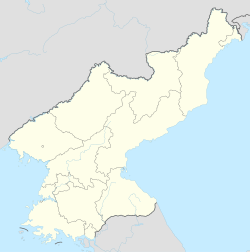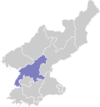| Tŏkch'ŏn 덕천 | |
|---|---|
| Municipal City | |
| Korean transcription(s) | |
| • Chosŏn'gŭl | 덕천시 |
| • Hancha | 德川市 |
| • McCune–Reischauer | Tŏkch'ŏn-si |
| • Revised Romanization | Deokcheon-si |
 Map of South Pyongan showing the location of Tokchon Map of South Pyongan showing the location of Tokchon | |
 | |
| Coordinates: 39°45′40″N 126°18′43″E / 39.761°N 126.312°E / 39.761; 126.312 | |
| Country | North Korea |
| Province | South P'yŏngan |
| Administrative divisions | 22 tong, 10 ri |
| Population | |
| • Total | 237,133 |
| • Dialect | P'yŏngan |
| Time zone | UTC+9 (Pyongyang Time) |
Tŏkch'ŏn (Korean pronunciation: [tʌk̚.tsʰʌn]) is a si, or city, in northern South P'yŏngan province, North Korea. It is bordered by Nyŏngwŏn and Maengsan to the east, Kujang county in North P'yŏngan province to the north, Kaech'ŏn to the west and Pukch'ang to the south. It was known as Tokugawa during Japanese rule.
History
A 1984 survey unearthed fragmented pieces of pottery about 3km north from the Tokchon city limits dating from the Juelmun pottery period. However, little is known about the founding of the current city of Tokchon. The earliest records of Tokchon point to a Goryeo period founding of around with scriptures mentioning a fort named Bajung (바중) owned by a local lord c.950 A.D. The city was only named the current Tokchon during the Choson period (1392-1897). The city was heavily bombed by the USAF in the Korean War, with estimates of 65% of the city destroyed and 15-25,000 killed. On April 28, 2017, a Hwasong-12 intermediate-range ballistic missile launched from near Pukchang Airport reportedly crashed into Ch'ŏngsin-dong, Tokchon, damaging several structures in the city.
Administrative divisions
Tŏkch'ŏn-si is divided into 22 tong (neighbourhoods) and 10 ri (villages):
|
|
Economy
The Sŭngri Motor Plant (with associated workshops) has been one of the few domestic sources of both low-cost replicas of foreign passenger cars and military-service trucks in North Korea since it was established in 1950, and developed through the massive militarization campaigns of Kim Il Sung in the 1970s and 80s.
However, the total depletion of foreign credit by the end of the 1980s caused the manufacturing industry to implode; the supply of steel for metalworking at Sŭngri slowed to a trickle, and even when available, the production lines had regular power outages. The severe famine in the countryside also caused an exodus of starving peasants to the cities, further straining food supplies and worker productivity. 20,000 cars and trucks were made in Tŏkch'ŏn in 1980; by 1996 the number was just 150, all of which were Army trucks, some later modified as rocket artillery launchers.
Transportation
Tŏkch'ŏn-si is served by the Korean State Railway's P'yŏngdŏk line and five branchlines.
See also
Further reading
- Dormels, Rainer. North Korea's Cities: Industrial facilities, internal structures and typification. Jimoondang, 2014. ISBN 978-89-6297-167-5
References
- Panda, Ankit; Schmerler, Dave (January 3, 2018). "When a North Korean Missile Accidentally Hit a North Korean City". The Diplomat. Archived from the original on January 4, 2018. Retrieved January 4, 2018.
On April 28, 2017, North Korea launched a single Hwasong-12/KN17 intermediate-range ballistic missile (IRBM) from Pukchang Airfield in South Pyongan Province (the Korean People's Army's Air and Anti-Air Force Unit 447 in Ryongak-dong, Sunchon City, to be more precise). That missile failed shortly after launch and crashed in the Chongsin-dong, in North Korean city of Tokchon, causing considerable damage to a complex of industrial or agricultural buildings.
- "Tokch'on-Kun - North Korean Special Weapons Facilities".
External links
- In Korean language online encyclopedias:
- City profile of Tokchon Archived 2016-03-10 at the Wayback Machine
| South P'yŏngan Province | ||
|---|---|---|
| Capital |  | |
| Cities | ||
| Districts | ||
| Counties | ||
| Cities in North Korea | |
|---|---|
| Directly governed city | |
| Special cities | |
| Provincial capitals | |
| Other cities | |
| 2,000,000 and more |
|
|---|---|
| 1,000,000–1,999,999 |
|
| 500,000–999,999 | |
| 200,000–499,999 | |
This North Korea location article is a stub. You can help Misplaced Pages by expanding it. |